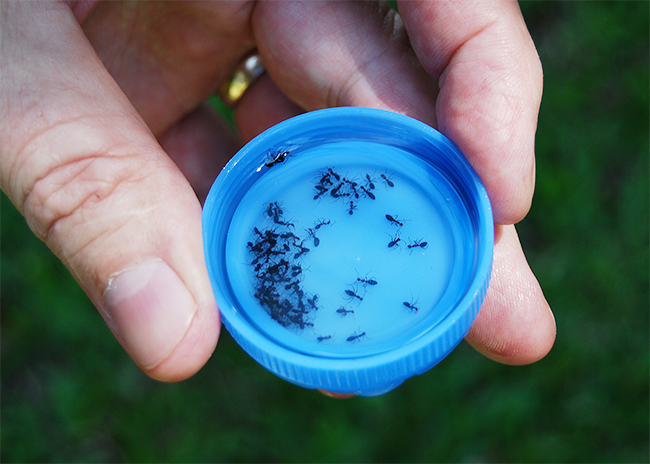Exotic ants
Browsing ant
Browsing ants (Lepisiota frauenfeldi) are an exotic invasive ant species of national significance and a serious environmental pest.
They have not established in Australia but there have been several small infestations detected in the Northern Territory (NT), Western Australia and Queensland.
They are commonly found in South East Asia, including Timor-Leste.
Browsing ants are omnivorous. They are often found on the ground as well as in trees, leaf litter and infrastructure, including electrical boxes.
A distinct behavioural trait is that when undisturbed, they generally move around very slowly. When disturbed, they run around in a haphazard way.
Current situation in the NT
Browsing ants were identified in the Darwin Port region on 6 August 2015 by Australian Government biosecurity officers.
Since then, 23 infected locations have been detected. Initially, known infestations were limited to Berrimah, East Arm, Frances Bay and Wickham Point.
In September 2020, there was a detection near Kakadu which was a direct trace from the most recent detection in Darwin.
Only one infected location remains active, the other 22 have been resolved.
Treatment and surveillance
Treatment is underway at this most recent infestation and surveillance is being carried out to confirm that it has not spread into surrounding areas.
To eradicate this latest detection and show proof of freedom, funding for the National Browsing Ant Eradication Program (NBAEP) NT has been extended until December 2025.
As a result of NBAEP NT’s activities, 22 of the locations initially detected have been resolved. The remaining location is expected to be resolved by December 2025.
The Department of Industry, Tourism and Trade (DITT) has carried out extensive surveillance with help from Aboriginal ranger groups at remote sites across the NT, with no further detections.
Appearance
The browsing ant has all of the following features:
- slender
- shiny dark-brown colour
- 3 to 4 mm long
- long antennae
- long legs.
Impact
Invasive ant species are considered some of the most serious global pests.
They pose a significant environmental and economic threat as they can:
- cause native species decline
- alter ecosystem function
- minimise agriculture outputs
- impact national and international market access.
Impact on industry
They can also indirectly impact any industry that relies on transporting goods or services. This includes tourism, transport, logistics, construction and mining. This is because invasive ant species can easily spread undetected through shipping containers, vehicles, equipment and other goods.
Environmental impact
Browsing ants are ideally suited to Australian conditions. They form multi-queened super colonies that can reach very large numbers and displace or overwhelm native ants and invertebrates.
This means they will outcompete local ants and insects, strip native vegetation and disrupt ecosystems.
Browsing ants also threaten the NT environment, and agriculture and horticulture industry by farming and protecting damaging pests such as aphids, mealybugs and scale insects. These insects reduce plant health and can spread serious disease. They are not harmful to humans or animals.
How they spread
Browsing ants and other exotic invasive ant species can be transported through various pathways and materials.
They can travel via:
- planes
- trains
- marine vessels
- vehicles in freight
- shipping containers
- various equipment and heavy machinery
- luggage
- plant and soil matter.
Management
NBAEP NT uses several techniques for successful surveillance and control of browsing ants.
This includes luring, observation and odour detection dogs. Using different techniques increases the chance of detection and gives greater confidence in eradication efforts.
Treatment includes a combination of granulated bait specifically for nuisance ants and a spray treatment where browsing ant activity has been detected.
Afterwards, an intensive post-treatment surveillance program is carried out. Eradication can be declared once 2 years of surveillance is carried out indicating no presence of ants.
Your responsibilities
Biosecurity is everyone’s responsibility. To help protect the NT, you should do the following:
- Comply with movement restrictions on infested sites to prevent transport and spread of browsing ants.
- Check vehicle and goods when leaving any site where ants may be present.
- Check vehicles and property before moving to a new location, especially interstate.
- Avoid transporting plant or soil matter between states or territories.
- Watch out for exotic pests when dealing with imported goods and mail from overseas.
How to report
If you think you have seen browsing ants or exotic invasive ant species, call the exotic plant pest hotline on 1800 084 881.
You can also call the NBAEP NT program manager on 08 8999 2247 or email christopher.collins@nt.gov.au.
Print all pages in this section
Give feedback about this page.
Share this page:
URL copied!
